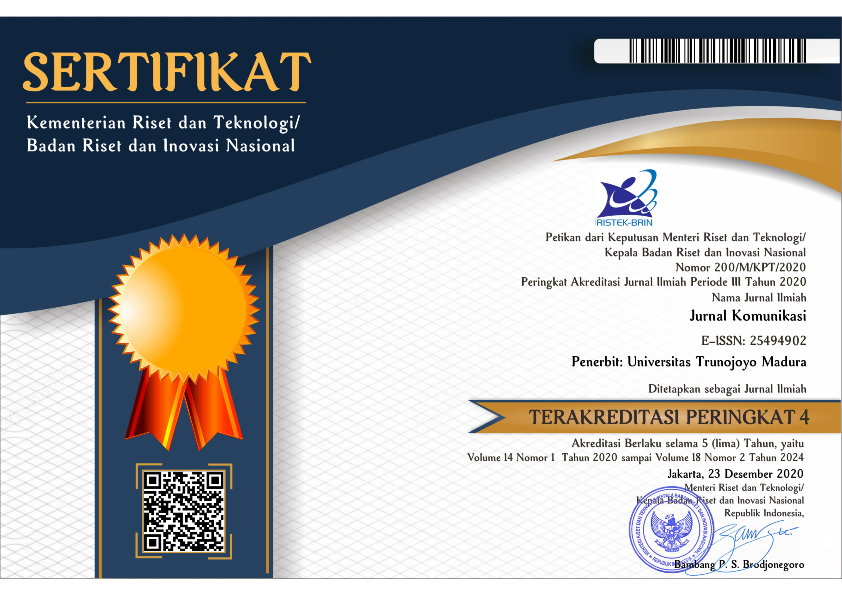THE MUSLIM SHOW: SOFT CONTRA "LABELING" MELALUI MEDIA SOSIAL
Abstract
Full Text:
PDF (Bahasa Indonesia)References
Alam, Arshad (2009). “Contextualising Muslim Identity: Ansaris, Deobandis, Barelwis” dalam Economic and Political Weekly,Vol. 44, No. 24 (Jun. 13 - 19, 2009), pp.
-92
Ahmad, Imtiaz (2005). “India and the Muslim World” dalam Jurnal Economic and Political Weekly,Vol. 40, No. 9 (Feb. 26 - Mar. 4, 2005), pp. 819-822.
Becker, Howard S (1966). Outsiders: Studies in Sociology Deviance. The Free Press.
New York.
Blumer, Herbert (1969). Symbolic Interactionism, Perspective and Method. University of California Press.
Chen, Micki (1983). “Pakistan : Atoms for Peace or War?” dalam Jurnal Harvard International Review,Vol. 6, No. 2 (November 1983), pp. 41-42.
Collins, (1955). “The Moslem Family In Britain” dalam Jurnal Social and Economic Studies,Vol. 4, No. 4 (December 1995), pp. 326-337. Sir Arthur Lewis Institute of Social and Economic StudiesUniversity of the West Indies.
Deely, John N (1990). Basics of Semiotics Advances in Semiotics. Indiana University Press.
Elsito, John L (2011). “What Everyone Needs to Know About Islam” diakses dari http:// www.oxfordislamicstudies.com.ezproxy.ugm.ac.id/wentkai.html pada Maret 2015.
Fathi, Asghar (1973). “Mass Media and a Moslem Immigrant Community in Canada” dalam jurnal Anthropologica New Series, Vol. 15, No. 2 (1973), pp. 201-230. Canadian Anthropology Society.
Ghazali, Effendi (n/a). Without Media There Can Be No Terrorism!, kompas.
Kickdekkel, David A (1998). “Being Muslim the Bosnian Way: Identity and Community in a Central Bosnian Village” dalam Jurnal Anthropological Quarterly,Vol. 71, No. 2 (Apr., 1998), pp. 99-100. The George Washington University Institute for Ethnographic Research.
McPhail, Thomas L (2006). Global Communication Theories, Stakeholders,and Trends.
nd ed. Blackwell Publishing.
Ramon, Grosfoguel (2006). “The Long-Durée Entanglement Between Islamophobia and Racism in the Modern/Colonial Capitalist/Patriarchal World-System: An Introduction” dalam Jurnal Human Architecture Vol.5 Issue 1. Pp. 1-12. Ahead Publishing House Okcir Press
Smith, Ken et all (2005). Handbook of Visual Communication. Lawrence Erlbaum.
Short, T.L (2007). Peirce’s Theory of Signs. Cambridge University Press.
Republika.com (2014). “The Muslim Show Gelak Tawa Islam di Perancis”. Dari http:// www.republika.co.id/berita/internasional/global/14/03/09/n26gfz-the-muslim- show-gelak-tawa-islam-di-perancis
DOI: https://doi.org/10.21107/ilkom.v9i1.1147
Refbacks
- There are currently no refbacks.
Copyright (c) 2016 Yuliana Rakhmawati

This work is licensed under a Creative Commons Attribution-ShareAlike 4.0 International License.
Jurnal Komunikasi by Universitas Trunojoyo Madura is licensed under a Creative Commons Attribution-ShareAlike 4.0 International License.














